Neutrino Oscillations in Neutrino-Dominated Accretion Around Rotating Black Holes
Abstract
1. Introduction
2. Hydrodynamics
2.1. Units, Velocities and Averaging
2.2. Conservation Laws
2.3. Equations of State
3. Neutrino Oscillations
3.1. Equations of Oscillation
- Due to axial symmetry, the neutrino density is constant along the direction. Moreover, since neutrinos follow null geodesics, we can set .
- Within the thin disk approximation (as represented by Equation (10)) the neutrino and matter densities are constant along the direction and the momentum change due to curvature along this direction can be neglected, that is, .
- In the LRF, the normalized radial momentum of a neutrino can be written as . Hence, the typical scale of the change of momentum with radius is , which obeys for . This means we can assume up to regions very close to the inner edge of the disk.
- We define an effective distance . For all the systems we evaluated, we found that it is comparable to the height of the disk ). This means that at any point of the disk we can calculate neutrino oscillations in a small regions assuming that both the electron density and neutrino densities are constant.
- We neglect energy and momentum transport between different regions of the disk by neutrinos that are recaptured by the disk due to curvature. This assumption is reasonable except for regions very close to the BH but is consistent with the thin disk model (see, e.g., [128]). We also assume initially that the neutrino content of neighboring regions of the disk (different values of r) do not affect each other. As a consequence of the results discussed above, we assume that at any point inside the disk and at any instant of time an observer can describe both the charged leptons and neutrinos as isotropic gases around small enough regions of the disk. This assumption is considerably restrictive but we will generalize it in Section 5.
4. Initial Conditions and Integration
5. Results and Analysis
6. Discussion
- The equation of vertical hydrostatic equilibrium, Equation (15), can be derived in several ways [124,127,131]. We followed a particular approach consistent with the assumptions in [127], in which we took the vertical average of a hydrostatic Euler equation in polar coordinates. The result is an equation that leads to smaller values of the disk pressure when compared with other models. It is expected that the pressure at the center of the disk is smaller than the average density multiplied by the local tidal acceleration at the equatorial plane. Still, the choice between the assortment of pressure relations is tantamount to the fine-tuning of the model. Within the thin disk approximation, all these approaches are equivalent, since they all assume vertical equilibrium and neglect self-gravity.
- Following the BdHN scenario for the explanation of GRBs associated with Type Ic SNe (see Section 2), we considered a gas composed of O at the outermost radius of the disk and followed the evolution of the ion content using the Saha equation to fix the local NSE. In [107], only He is present, and in [112], ions up to Fe are introduced. The affinity between these cases implies that this particular model of disk accretion is insensible to the initial mass fraction distribution. This is explained by the fact that the average binding energy for most ions is very similar; hence, any cooling or heating due to a redistribution of nucleons, given by the NSE, is negligible when compared to the energy consumed by direct photodisintegration of alpha particles. Additionally, once most ions are dissociated, the main cooling mechanism is neutrino emission, which is similar for all models; the modulo includes the supplementary neutrino emission processes included in addition to electron and positron capture. However, during our numerical calculations, we noticed that the inclusion of non-electron neutrino emission processes can reduce the electron fraction by up to . This effect was observed again during the simulation of flavor equipartition alluding to the need for detailed calculations of neutrino emissivities when establishing NSE state. We obtained similar results to [107] (see Figure 3), but by varying the accretion rate and fixing the viscosity parameter. This suggests that a more natural differentiating set of variables in the hydrodynamic equations of an -viscosity disk is the combination of the quotient and either or . This result is already evident in, for example, Figures 11 and 12 of [107], but was not mentioned there.
Author Contributions
Funding
Acknowledgments
Conflicts of Interest
Abbreviations
| BdHN | Binary-Driven Hypernova |
| BH | Black Hole |
| CF | Coordinate Frame |
| CO | Carbon–Oxygen Star |
| CRF | Co-rotating Frame |
| GRB | Gamma-ray Burst |
| IGC | Induced Gravitational Collapse |
| ISCO | Innermost Stable Circular Orbit |
| LNRF | Locally Non-Rotating Frame |
| MSW | Mikheyev–Smirnov–Wolfenstein |
| NDAF | Neutrino-Dominated Accretion Flows |
| NS | Neutron Star |
| NSE | Nuclear Statistical Equilibrium |
| SN | Supernova |
Appendix A. Transformations and Christoffel Symbols
Appendix B. Stress–Energy Tensor
Appendix C. Nuclear Statistical Equilibrium
Appendix D. Neutrino Interactions and Cross-Sections
| Symbol | Value | Name |
|---|---|---|
| W boson mass | ||
| 0.653 | Weak coupling constant | |
| 1.26 | Axial-vector coupling constant | |
| Fine structure constant | ||
| 0.231 | Weinberg angle | |
| 0.947 | Cabibbo angle | |
| Fermi coupling constant | ||
| Weak interaction vector constant for | ||
| Weak interaction axial-vector constant for | ||
| Weak interaction vector constant for | ||
| Weak interaction axial-vector constant for | ||
| Weak interaction cross-section |
Appendix D.1. Neutrino Emissivities
- Pair annihilation:
- Electron capture and positron capture: , and
- Plasmon decay: .
- Nucleon-nucleon bremsstrahlung .
Appendix D.2. Cross-Sections
- Neutrino annihilation: .
- Electron (anti)neutrino absorption by nucleons: and .
- (anti)neutrino scattering by baryons: and .
- (anti)neutrino scattering by electrons or positrons: and .
Appendix D.3. Neutrino-Antineutrino Pair Annihilation
References
- De Salas, P.F.; Forero, D.V.; Ternes, C.A.; Tortola, M.; Valle, J.W.F. Status of neutrino oscillations 2018: 3σ hint for normal mass ordering and improved CP sensitivity. Phys. Lett. B 2018, 782, 633–640. [Google Scholar] [CrossRef]
- Wolfenstein, L. Neutrino Oscillations in Matter. Phys. Rev. D 1978, 17, 2369–2374. [Google Scholar] [CrossRef]
- Mikheyev, S.P.; Smirnov, A.Y. Resonant amplification of ν oscillations in matter and solar-neutrino spectroscopy. Il Nuovo Cimento C 1986, 9, 17–26. [Google Scholar] [CrossRef]
- Barbieri, R.; Dolgov, A. Neutrino oscillations in the early universe. Nucl. Phys. B 1991, 349, 743–753. [Google Scholar] [CrossRef]
- Enqvist, K.; Kainulainen, K.; Maalampi, J. Refraction and Oscillations of Neutrinos in the Early Universe. Nucl. Phys. B 1991, 349, 754–790. [Google Scholar] [CrossRef]
- Savage, M.J.; Malaney, R.A.; Fuller, G.M. Neutrino Oscillations and the Leptonic Charge of the Universe. Astrophys. J. 1991, 368, 1–11. [Google Scholar] [CrossRef]
- Kostelecky, V.A.; Samuel, S. Neutrino oscillations in the early universe with an inverted neutrino mass hierarchy. Phys. Lett. B 1993, 318, 127–133. [Google Scholar] [CrossRef]
- Kostelecky, V.A.; Samuel, S. Nonlinear neutrino oscillations in the expanding universe. Phys. Rev. D 1994, 49, 1740–1757. [Google Scholar] [CrossRef]
- Kostelecký, V.; Pantaleone, J.; Samuel, S. Neutrino oscillations in the early universe. Phys. Lett. B 1993, 315, 46–50. [Google Scholar] [CrossRef]
- McKellar, B.H.J.; Thomson, M.J. Oscillating doublet neutrinos in the early universe. Phys. Rev. D 1994, 49, 2710–2728. [Google Scholar] [CrossRef]
- Lunardini, C.; Smirnov, A.Y. High-energy neutrino conversion and the lepton asymmetry in the universe. Phys. Rev. D 2001, 64, 73006. [Google Scholar] [CrossRef]
- Dolgov, A.D.; Hansen, S.H.; Pastor, S.; Petcov, S.T.; Raffelt, G.G.; Semikoz, D.V. Cosmological bounds on neutrino degeneracy improved by flavor oscillations. Nucl. Phys. B 2002, 632, 363–382. [Google Scholar] [CrossRef]
- Wong, Y.Y. Analytical treatment of neutrino asymmetry equilibration from flavor oscillations in the early universe. Phys. Rev. D 2002, 66, 25015. [Google Scholar] [CrossRef]
- Abazajian, K.N.; Beacom, J.F.; Bell, N.F. Stringent constraints on cosmological neutrino-antineutrino asymmetries from synchronized flavor transformation. Phys. Rev. D 2002, 66, 13008. [Google Scholar] [CrossRef]
- Kirilova, D.P. Neutrino oscillations and the early universe. Cent. Eur. J. Phys. 2004, 2, 467–491. [Google Scholar] [CrossRef]
- Bahcall, J.N.; Concepcion Gonzalez-Garcia, M.; na-Garay, C.P. Solar Neutrinos Before and After KamLAND. J. High Energy Phys. 2003, 2003, 09. [Google Scholar] [CrossRef]
- Balantekin, A.B.; Yuksel, H. Global Analysis of Solar Neutrino and KamLAND Data. J. Phys. G Nucl. Part. Phys. 2003, 29, 665. [Google Scholar] [CrossRef]
- Fogli, G.L.; Lisi, E.; Marrone, A.; Montanino, D.; Palazzo, A.; Rotunno, A.M. Neutrino Oscillations: A Global Analysis. arXiv 2003, arXiv:0310012. [Google Scholar] [CrossRef]
- de Holanda, P.C.; Smirnov, A.Y. Solar neutrinos: The SNO salt phase results and physics of conversion. Astropart. Phys. 2004, 21, 287–301. [Google Scholar] [CrossRef][Green Version]
- Giunti, C. Status of neutrino masses and mixing. Eur. Phys. J. C 2004, 33, 852–856. [Google Scholar] [CrossRef][Green Version]
- Maltoni, M.; Schwetz, T.; Tórtola, M.A.; Valle, J.W. Status of three-neutrino oscillations after the SNO-salt data. Phys. Rev. D 2003, 68, 113010. [Google Scholar] [CrossRef]
- Dighe, A. Supernova neutrino oscillations: What do we understand? J. Phys. Conf. Ser. 2010, 203, 012015. [Google Scholar] [CrossRef]
- Haxton, W.C.; Hamish Robertson, R.G.; Serenelli, A.M. Solar Neutrinos: Status and Prospects. Annu. Rev. Astron. Astrophys. 2013, 51, 21–61. [Google Scholar] [CrossRef]
- Vissani, F. Solar neutrino physics on the beginning of 2017. Nucl. Phys. At. Energy 2017, 18, 5–12. [Google Scholar] [CrossRef]
- Notzold, D.; Raffelt, G. Neutrino Dispersion at Finite Temperature and Density. Nucl. Phys. B 1988, 307, 924–936. [Google Scholar] [CrossRef]
- Pantaleone, J. Neutrino oscillations at high densities. Phys. Lett. B 1992, 287, 128–132. [Google Scholar] [CrossRef]
- Qian, Y.Z.; Fuller, G.M. Neutrino-neutrino scattering and matter enhanced neutrino flavor transformation in Supernovae. Phys. Rev. D 1995, 51, 1479–1494. [Google Scholar] [CrossRef] [PubMed]
- Pastor, S.; Raffelt, G. Flavor oscillations in the supernova hot bubble region: Nonlinear effects of neutrino background. Phys. Rev. Lett. 2002, 89, 191101. [Google Scholar] [CrossRef]
- Duan, H.; Fuller, G.M.; Qian, Y.Z. Collective neutrino flavor transformation in supernovae. Phys. Rev. D 2006, 74, 123004. [Google Scholar] [CrossRef]
- Sawyer, R.F. Speed-up of neutrino transformations in a supernova environment. Phys. Rev. D 2005, 72, 45003. [Google Scholar] [CrossRef]
- Fuller, G.M.; Qian, Y.Z. Simultaneous flavor transformation of neutrinos and antineutrinos with dominant potentials from neutrino-neutrino forward scattering. Phys. Rev. D 2006, 73, 23004. [Google Scholar] [CrossRef]
- Duan, H.; Fuller, G.M.; Carlson, J.; Qian, Y.Z. Coherent Development of Neutrino Flavor in the Supernova Environment. Phys. Rev. Lett. 2006, 97, 241101. [Google Scholar] [CrossRef] [PubMed]
- Fogli, G.L.; Lisi, E.; Marrone, A.; Mirizzi, A. Collective neutrino flavor transitions in supernovae and the role of trajectory averaging. JCAP 2007, 0712, 10. [Google Scholar] [CrossRef]
- Duan, H.; Fuller, G.M.; Qian, Y.Z. A Simple Picture for Neutrino Flavor Transformation in Supernovae. Phys. Rev. D 2007, 76, 85013. [Google Scholar] [CrossRef]
- Raffelt, G.G.; Sigl, G. Self-induced decoherence in dense neutrino gases. Phys. Rev. D 2007, 75, 83002. [Google Scholar] [CrossRef]
- Esteban-Pretel, A.; Pastor, S.; Tomas, R.; Raffelt, G.G.; Sigl, G. Decoherence in supernova neutrino transformations suppressed by deleptonization. Phys. Rev. D 2007, 76, 125018. [Google Scholar] [CrossRef]
- Esteban-Pretel, A.; Pastor, S.; Tomas, R.; Raffelt, G.G.; Sigl, G. Mu-tau neutrino refraction and collective three-flavor transformations in supernovae. Phys. Rev. D 2008, 77, 65024. [Google Scholar] [CrossRef]
- Chakraborty, S.; Choubey, S.; Dasgupta, B.; Kar, K. Effect of Collective Flavor Oscillations on the Diffuse Supernova Neutrino Background. JCAP 2008, 0809, 13. [Google Scholar] [CrossRef]
- Duan, H.; Fuller, G.M.; Carlson, J.; Qian, Y.Z. Flavor Evolution of the Neutronization Neutrino Burst from an O-Ne-Mg Core-Collapse Supernova. Phys. Rev. Lett. 2008, 100, 21101. [Google Scholar] [CrossRef]
- Duan, H.; Fuller, G.M.; Carlson, J. Simulating nonlinear neutrino flavor evolution. Comput. Sci. Dis. 2008, 1, 015007. [Google Scholar] [CrossRef][Green Version]
- Dasgupta, B.; Dighe, A.; Mirizzi, A. Identifying neutrino mass hierarchy at extremely small theta(13) through Earth matter effects in a supernova signal. Phys. Rev. Lett. 2008, 101, 171801. [Google Scholar] [CrossRef] [PubMed]
- Dasgupta, B.; Dighe, A. Collective three-flavor oscillations of supernova neutrinos. Phys. Rev. D 2008, 77, 113002. [Google Scholar] [CrossRef]
- Sawyer, R.F. The multi-angle instability in dense neutrino systems. Phys. Rev. D 2009, 79, 105003. [Google Scholar] [CrossRef]
- Duan, H.; Fuller, G.M.; Qian, Y.Z. Collective Neutrino Oscillations. Ann. Rev. Nucl. Part. Sci. 2010, 60, 569–594. [Google Scholar] [CrossRef]
- Wu, M.R.; Qian, Y.Z. Resonances Driven by a Neutrino Gyroscope and Collective Neutrino Oscillations in Supernovae. Phys. Rev. D 2011, 84, 45009. [Google Scholar] [CrossRef]
- Bilenky, S.M. Neutrino oscillations: Brief history and present status. arXiv 2014, arXiv:1408.2864. [Google Scholar]
- Kneller, J.P. The Physics Of Supernova Neutrino Oscillations. In Proceedings of the 12th Conference on the Intersections of Particle and Nuclear Physics (CIPANP 2015), Vail, CO, USA, 19–24 May 2015. [Google Scholar]
- Volpe, C. Theoretical developments in supernova neutrino physics: Mass corrections and pairing correlators. J. Phys. Conf. Ser. 2016, 718, 62068. [Google Scholar] [CrossRef]
- Mirizzi, A.; Tamborra, I.; Janka, H.T.; Saviano, N.; Scholberg, K.; Bollig, R.; Hüdepohl, L.; Chakraborty, S. Supernova neutrinos: Production, oscillations and detection. Nuovo Cimento Riv. Ser. 2016, 39, 1–112. [Google Scholar] [CrossRef]
- Horiuchi, S.; Kneller, J.P. What can be learned from a future supernova neutrino detection? J. Phys. G Nucl. Phys. 2018, 45, 43002. [Google Scholar] [CrossRef]
- Zaizen, M.; Yoshida, T.; Sumiyoshi, K.; Umeda, H. Collective neutrino oscillations and detectabilities in failed supernovae. Phys. Rev. D 2018, 98, 103020. [Google Scholar] [CrossRef]
- Zhang, B. The Physics of Gamma-ray Bursts; Cambridge University Press: Cambridge, UK, 2018. [Google Scholar] [CrossRef]
- Ruffini, R.; Bernardini, M.G.; Bianco, C.L.; Vitagliano, L.; Xue, S.S.; Chardonnet, P.; Fraschetti, F.; Gurzadyan, V. Black Hole Physics and Astrophysics: The GRB-Supernova Connection and URCA-1 - URCA-2. In The Tenth Marcel Grossmann Meeting, Proceedings of the MG10 Meeting Held at Brazilian Center for Research in Physics (CBPF), Rio de Janeiro, Brazil, 20–26 July 2003; Novello, M., Bergliaffa, S.P., Ruffini, R., Eds.; World Scientific Publishing: Singapore, 2006; Volume 3, p. 369. [Google Scholar] [CrossRef]
- Ruffini, R.; Bernardini, M.G.; Bianco, C.L.; Caito, L.; Chardonnet, P.; Cherubini, C.; Dainotti, M.G.; Fraschetti, F.; Geralico, A.; Guida, R.; et al. On Gamma-ray Bursts. In The Eleventh Marcel Grossmann Meeting On Recent Developments in Theoretical and Experimental General Relativity, Gravitation and Relativistic Field Theories; Kleinert, H., Jantzen, R.T., Ruffini, R., Eds.; World Scientific: Singapore, 2008; pp. 368–505. [Google Scholar] [CrossRef]
- Izzo, L.; Rueda, J.A.; Ruffini, R. GRB 090618: A candidate for a neutron star gravitational collapse onto a black hole induced by a type Ib/c supernova. Astron. Astrophys. 2012, 548, L5. [Google Scholar] [CrossRef]
- Rueda, J.A.; Ruffini, R. On the Induced Gravitational Collapse of a Neutron Star to a Black Hole by a Type Ib/c Supernova. Astrophys. J. 2012, 758, L7. [Google Scholar] [CrossRef]
- Fryer, C.L.; Rueda, J.A.; Ruffini, R. Hypercritical Accretion, Induced Gravitational Collapse, and Binary-Driven Hypernovae. Astrophys. J. 2014, 793, L36. [Google Scholar] [CrossRef]
- Ruffini, R.; Wang, Y.; Enderli, M.; Muccino, M.; Kovacevic, M.; Bianco, C.L.; Penacchioni, A.V.; Pisani, G.B.; Rueda, J.A. GRB 130427A and SN 2013cq: A Multi-wavelength Analysis of An Induced Gravitational Collapse Event. Astrophys. J. 2015, 798, 10. [Google Scholar] [CrossRef]
- Fryer, C.L.; Oliveira, F.G.; Rueda, J.A.; Ruffini, R. Neutron-Star-Black-Hole Binaries Produced by Binary-Driven Hypernovae. Phys. Rev. Lett. 2015, 115, 231102. [Google Scholar] [CrossRef]
- Wang, Y.; Rueda, J.A.; Ruffini, R.; Becerra, L.; Bianco, C.; Becerra, L.; Li, L.; Karlica, M. Two Predictions of Supernova: GRB 130427A/SN 2013cq and GRB 180728A/SN 2018fip. Astrophys. J. 2019, 874, 39. [Google Scholar] [CrossRef]
- Rueda, J.A.; Ruffini, R.; Karlica, M.; Moradi, R.; Wang, Y. Magnetic Fields and Afterglows of BdHNe: Inferences from GRB 130427A, GRB 160509A, GRB 160625B, GRB 180728A, and GRB 190114C. Astrophys. J. 2020, 893, 148. [Google Scholar] [CrossRef]
- Rueda, J.A.; Ruffini, R.; Wang, Y. Induced Gravitational Collapse, Binary-Driven Hypernovae, Long Gramma-ray Bursts and Their Connection with Short Gamma-ray Bursts. Universe 2019, 5, 110. [Google Scholar] [CrossRef]
- Becerra, L.; Bianco, C.L.; Fryer, C.L.; Rueda, J.A.; Ruffini, R. On the Induced Gravitational Collapse Scenario of Gamma-ray Bursts Associated with Supernovae. Astrophys. J. 2016, 833, 107. [Google Scholar] [CrossRef]
- Bianco, C.L.; Ruffini, R.; Xue, S. The elementary spike produced by a pure e+e- pair-electromagnetic pulse from a Black Hole: The PEM Pulse. Astron. Astrophys. 2001, 368, 377–390. [Google Scholar] [CrossRef]
- Ruffini, R.; Moradi, R.; Rueda, J.A.; Becerra, L.; Bianco, C.L.; Cherubini, C.; Filippi, S.; Chen, Y.C.; Karlica, M.; Sahakyan, N.; et al. On the GeV Emission of the Type I BdHN GRB 130427A. Astrophys. J. 2019, 886, 82. [Google Scholar] [CrossRef]
- Ruffini, R.; Melon Fuksman, J.D.; Vereshchagin, G.V. On the Role of a Cavity in the Hypernova Ejecta of GRB 190114C. Astrophys. J. 2019, 883, 191. [Google Scholar] [CrossRef]
- Ruffini, R.; Wang, Y.; Aimuratov, Y.; Barres de Almeida, U.; Becerra, L.; Bianco, C.L.; Chen, Y.C.; Karlica, M.; Kovacevic, M.; Li, L.; et al. Early X-ray Flares in GRBs. Astrophys. J. 2018, 852, 53. [Google Scholar] [CrossRef]
- Ruffini, R.; Karlica, M.; Sahakyan, N.; Rueda, J.A.; Wang, Y.; Mathews, G.J.; Bianco, C.L.; Muccino, M. A GRB Afterglow Model Consistent with Hypernova Observations. Astrophys. J. 2018, 869, 101. [Google Scholar] [CrossRef]
- Becerra, L.; Cipolletta, F.; Fryer, C.L.; Rueda, J.A.; Ruffini, R. Angular Momentum Role in the Hypercritical Accretion of Binary-driven Hypernovae. Astrophys. J. 2015, 812, 100. [Google Scholar] [CrossRef]
- Becerra, L.; Ellinger, C.L.; Fryer, C.L.; Rueda, J.A.; Ruffini, R. SPH Simulations of the Induced Gravitational Collapse Scenario of Long Gamma-ray Bursts Associated with Supernovae. Astrophys. J. 2019, 871, 14. [Google Scholar] [CrossRef]
- Becerra, L.; Guzzo, M.M.; Rossi-Torres, F.; Rueda, J.A.; Ruffini, R.; Uribe, J.D. Neutrino Oscillations within the Induced Gravitational Collapse Paradigm of Long Gamma-ray Bursts. Astrophys. J. 2018, 852, 120. [Google Scholar] [CrossRef]
- Goodman, J. Are gamma-ray bursts optically thick? Astrophys. J. 1986, 308, L47–L50. [Google Scholar] [CrossRef]
- Paczynski, B. Gamma-ray bursters at cosmological distances. Astrophys. J. 1986, 308, L43–L46. [Google Scholar] [CrossRef]
- Eichler, D.; Livio, M.; Piran, T.; Schramm, D.N. Nucleosynthesis, neutrino bursts and gamma-rays from coalescing neutron stars. Nature 1989, 340, 126–128. [Google Scholar] [CrossRef]
- Narayan, R.; Piran, T.; Shemi, A. Neutron star and black hole binaries in the Galaxy. Astrophys. J. 1991, 379, L17–L20. [Google Scholar] [CrossRef]
- Balbus, S.A.; Hawley, J.F. A powerful local shear instability in weakly magnetized disks. I—Linear analysis. II—Nonlinear evolution. Astrophys. J. 1991, 376, 214–233. [Google Scholar] [CrossRef]
- Hawley, J.F.; Balbus, S.A. A Powerful Local Shear Instability in Weakly Magnetized Disks. II. Nonlinear Evolution. Astrophys. J. 1991, 376, 223. [Google Scholar] [CrossRef]
- Balbus, S.A.; Hawley, J.F. Instability, turbulence, and enhanced transport in accretion disks. Rev. Mod. Phys. 1998, 70, 1–53. [Google Scholar] [CrossRef]
- Balbus, S.A. Enhanced Angular Momentum Transport in Accretion Disks. Annu. Rev. Astron. Astrophys. 2003, 41, 555–597. [Google Scholar] [CrossRef]
- Shakura, N.I.; Sunyaev, R.A. Black holes in binary systems. Observational appearance. Astron. Astrophys. 1973, 24, 337–355. [Google Scholar]
- King, A.R.; Pringle, J.E.; Livio, M. Accretion disc viscosity: How big is alpha? Mon. Not. R. Astron. Soc. 2007, 376, 1740–1746. [Google Scholar] [CrossRef]
- Pessah, M.E.; Chan, C.K.; Psaltis, D. The fundamental difference between shear alpha viscosity and turbulent magnetorotational stresses. Mon. Not. R. Astron. Soc. 2008, 383, 683–690. [Google Scholar] [CrossRef]
- King, A. Accretion disc theory since Shakura and Sunyaev. Mem. Soc. Astron. Ital. 2012, 83, 466. [Google Scholar]
- Kotko, I.; Lasota, J.P. The viscosity parameter α and the properties of accretion disc outbursts in close binaries. Astron. Astrophys. 2012, 545, A115. [Google Scholar] [CrossRef][Green Version]
- Pringle, J.E. Accretion discs in astrophysics. Annu. Rev. Astron. Astrophys. 1981, 19, 137–162. [Google Scholar] [CrossRef]
- Krolik, J.H. Active Galactic Nuclei: From the Central Black Hole to the Galactic Environment; Princeton University Press: Princeton, NJ, USA, 1999. [Google Scholar]
- Abramowicz, M.A.; Björnsson, G.; Pringle, J.E. Theory of Black Hole Accretion Discs; Cambridge University Press: Cambridge, UK, 1999; p. 309. [Google Scholar]
- Manmoto, T. Advection-dominated Accretion Flow around a Kerr Black Hole. Astrophys. J. 2000, 534, 734–746. [Google Scholar] [CrossRef]
- Frank, J.; King, A.; Raine, D.J. Accretion Power in Astrophysics, 3rd ed.; Cambridge University Press: Cambridge, UK, 2002; p. 398. [Google Scholar]
- Blaes, O.M. Course 3: Physics Fundamentals of Luminous Accretion Disks around Black Holes. In Accretion Discs, Jets and High Energy Phenomena in Astrophysics; Beskin, V., Henri, G., Menard, F., Pelletier, G., Dalibard, J., Eds.; Springer: Berlin/Heidelberg, Germany, 2004; pp. 137–185. [Google Scholar]
- Narayan, R.; McClintock, J.E. Advection-dominated accretion and the black hole event horizon. New Astron. Rev. 2008, 51, 733–751. [Google Scholar] [CrossRef]
- Kato, S.; Fukue, J.; Mineshige, S. Black-Hole Accretion Disks—Towards a New Paradigm—; Kyoto University Press: Kyoto, Japan, 2008. [Google Scholar]
- Qian, L.; Abramowicz, M.A.; Fragile, P.C.; Horák, J.; Machida, M.; Straub, O. The Polish doughnuts revisited. I. The angular momentum distribution and equipressure surfaces. Astron. Astrophys. 2009, 498, 471–477. [Google Scholar] [CrossRef]
- Montesinos, M. Review: Accretion Disk Theory. arXiv 2012, arXiv:1203.6851. [Google Scholar]
- Abramowicz, M.A.; Fragile, P.C. Foundations of Black Hole Accretion Disk Theory. Living Rev. Relativ. 2013, 16, 1. [Google Scholar] [CrossRef] [PubMed]
- Yuan, F.; Narayan, R. Hot Accretion Flows Around Black Holes. Annu. Rev. Astron. Astrophys. 2014, 52, 529–588. [Google Scholar] [CrossRef]
- Blaes, O. General Overview of Black Hole Accretion Theory. Space Sci. Rev. 2014, 183, 21–41. [Google Scholar] [CrossRef]
- Lasota, J.P. Black Hole Accretion Discs. Astrophysics of Black Holes: From Fundamental Aspects to Latest Developments; Bambi, C., Ed.; Astrophysics and Space Science Library; Springer: Berlin/Heidelberg, Germany, 2016; Volume 440, p. 1. [Google Scholar] [CrossRef]
- Liu, T.; Gu, W.M.; Zhang, B. Neutrino-dominated accretion flows as the central engine of gamma-ray bursts. New Astron. Rev. 2017, 79, 1–25. [Google Scholar] [CrossRef]
- Popham, R.; Woosley, S.E.; Fryer, C. Hyperaccreting Black Holes and Gamma-ray Bursts. Astrophys. J. 1999, 518, 356–374. [Google Scholar] [CrossRef]
- Narayan, R.; Piran, T.; Kumar, P. Accretion Models of Gamma-ray Bursts. Astrophys. J. 2001, 557, 949–957. [Google Scholar] [CrossRef]
- Kohri, K.; Mineshige, S. Can Neutrino-cooled Accretion Disks Be an Origin of Gamma-ray Bursts? Astrophys. J. 2002, 577, 311–321. [Google Scholar] [CrossRef]
- Di Matteo, T.; Perna, R.; Narayan, R. Neutrino Trapping and Accretion Models for Gamma-ray Bursts. Astrophys. J. 2002, 579, 706–715. [Google Scholar] [CrossRef]
- Kohri, K.; Narayan, R.; Piran, T. Neutrino-dominated Accretion and Supernovae. Astrophys. J. 2005, 629, 341–361. [Google Scholar] [CrossRef]
- Lee, W.H.; Ramirez-Ruiz, E.; Page, D. Dynamical Evolution of Neutrino-cooled Accretion Disks: Detailed Microphysics, Lepton-driven Convection, and Global Energetics. Astrophys. J. 2005, 632, 421–437. [Google Scholar] [CrossRef]
- Gu, W.M.; Liu, T.; Lu, J.F. Neutrino-dominated Accretion Models for Gamma-ray Bursts: Effects of General Relativity and Neutrino Opacity. Astrophys. J. 2006, 643, L87–L90. [Google Scholar] [CrossRef]
- Chen, W.X.; Beloborodov, A.M. Neutrino-cooled Accretion Disks around Spinning Black Holes. Astrophys. J. 2007, 657, 383–399. [Google Scholar] [CrossRef]
- Kawanaka, N.; Mineshige, S. Neutrino-cooled Accretion Disk and Its Stability. Astrophys. J. 2007, 662, 1156–1166. [Google Scholar] [CrossRef]
- Janiuk, A.; Yuan, Y.F. The role of black hole spin and magnetic field threading the unstable neutrino disk in gamma ray bursts. Astron. Astrophys. 2010, 509, A55. [Google Scholar] [CrossRef]
- Kawanaka, N.; Piran, T.; Krolik, J.H. Jet Luminosity from Neutrino-dominated Accretion Flows in Gamma-ray Bursts. Astrophys. J. 2013, 766, 31. [Google Scholar] [CrossRef]
- Luo, S.; Yuan, F. Global neutrino heating in hyperaccretion flows. Mon. Not. R. Astron. Soc. 2013, 431, 2362–2370. [Google Scholar] [CrossRef][Green Version]
- Xue, L.; Liu, T.; Gu, W.M.; Lu, J.F. Relativistic Global Solutions of Neutrino-dominated Accretion Flows. Astrophys. J. Suppl. Ser. 2013, 207, 23. [Google Scholar] [CrossRef]
- Malkus, A.; Kneller, J.P.; McLaughlin, G.C.; Surman, R. Neutrino oscillations above black hole accretion disks: Disks with electron-flavor emission. Phys. Rev. D 2012, 86, 85015. [Google Scholar] [CrossRef]
- Frensel, M.; Wu, M.R.; Volpe, C.; Perego, A. Neutrino flavor evolution in binary neutron star merger remnants. Phys. Rev. D 2017, 95, 23011. [Google Scholar] [CrossRef]
- Tian, J.Y.; Patwardhan, A.V.; Fuller, G.M. Neutrino flavor evolution in neutron star mergers. Phys. Rev. D 2017, 96, 43001. [Google Scholar] [CrossRef]
- Wu, M.R.; Tamborra, I. Fast neutrino conversions: Ubiquitous in compact binary merger remnants. Phys. Rev. D 2017, 95, 103007. [Google Scholar] [CrossRef]
- Padilla-Gay, I.; Shalgar, S.; Tamborra, I. Multi-Dimensional Solution of Fast Neutrino Conversions in Binary Neutron Star Merger Remnants. arXiv 2020, arXiv:2009.01843. [Google Scholar]
- Janiuk, A.; Mioduszewski, P.; Moscibrodzka, M. Accretion and outflow from a magnetized, neutrino cooled torus around the gamma-ray burst central engine. Astrophys. J. 2013, 776, 105. [Google Scholar] [CrossRef]
- Janiuk, A. Microphysics in the Gamma-ray Burst Central Engine. Astrophys. J. 2017, 837, 39. [Google Scholar] [CrossRef]
- Janiuk, A.; Sapountzis, K.; Mortier, J.; Janiuk, I. Numerical Simulations of Black Hole Accretion Flows. arXiv 2018, arXiv:1805.11305. [Google Scholar]
- Janiuk, A. The r-process Nucleosynthesis in the Outflows from Short GRB Accretion Disks. Astrophys. J. 2019, 882, 163. [Google Scholar] [CrossRef]
- Bardeen, J.M. A Variational Principle for Rotating Stars in General Relativity. Astrophys. J. 1970, 162, 71. [Google Scholar] [CrossRef]
- Bardeen, J.M.; Press, W.H.; Teukolsky, S.A. Rotating Black Holes: Locally Nonrotating Frames, Energy Extraction, and Scalar Synchrotron Radiation. Astrophys. J. 1972, 178, 347–370. [Google Scholar] [CrossRef]
- Gammie, C.F.; Popham, R. Advection-dominated Accretion Flows in the Kerr Metric. I. Basic Equations. Astrophys. J. 1998, 498, 313–326. [Google Scholar] [CrossRef]
- Bardeen, J.M. Kerr Metric Black Holes. Nature 1970, 226, 64–65. [Google Scholar] [CrossRef]
- Thorne, K.S. Disk-Accretion onto a Black Hole. II. Evolution of the Hole. Astrophys. J. 1974, 191, 507–520. [Google Scholar] [CrossRef]
- Novikov, I.D.; Thorne, K.S. Astrophysics of black holes. In Black Holes (Les Astres Occlus); Dewitt, C., Dewitt, B.S., Eds.; Gordon and Breach Science Publishers Inc.: New York, NY, USA, 1973; pp. 343–450. [Google Scholar]
- Page, D.N.; Thorne, K.S. Disk-Accretion onto a Black Hole. Time-Averaged Structure of Accretion Disk. Astrophys. J. 1974, 191, 499–506. [Google Scholar] [CrossRef]
- Landau, L.D.; Lifshitz, E.M. Fluid Mechanics; Pergamon Press: Oxford, UK, 1959. [Google Scholar]
- Abramowicz, M.A.; Chen, X.M.; Granath, M.; Lasota, J.P. Advection-Dominated Accretion Flows Around Kerr Black Holes. Astrophys. J. 1996, 471, 762–773. [Google Scholar] [CrossRef]
- Abramowicz, M.A.; Lanza, A.; Percival, M.J. Accretion Disks around Kerr Black Holes: Vertical Equilibrium Revisited. Astrophys. J. 1997, 479, 179–183. [Google Scholar] [CrossRef]
- Misner, C.W.; Thorne, K.S.; Wheeler, J.A. Gravitation; Princeton University Press: Princeton, NJ, USA, 1973. [Google Scholar]
- Mihalas, D.; Mihalas, B.W. Foundations of Radiation Hydrodynamics; Oxford University Press: Oxford, UK, 1984. [Google Scholar]
- Clifford, F.E.; Tayler, R.J. The equilibrium distribution of nuclides in matter at high temperatures. Mon. Not. R. Astron. Soc. 1965, 69, 21. [Google Scholar] [CrossRef][Green Version]
- Calder, A.C.; Townsley, D.M.; Seitenzahl, I.R.; Peng, F.; Messer, O.E.B.; Vladimirova, N.; Brown, E.F.; Truran, J.W.; Lamb, D.Q. Capturing the Fire: Flame Energetics and Neutronization for Type Ia Supernova Simulations. Astrophys. J. 2007, 656, 313–332. [Google Scholar] [CrossRef][Green Version]
- Mavrodiev, S.C.; Deliyergiyev, M.A. Modification of the nuclear landscape in the inverse problem framework using the generalized Bethe-Weizsäcker mass formula. Int. J. Mod. Phys. E 2018, 27, 1850015. [Google Scholar] [CrossRef]
- Rauscher, T.; Thielemann, F.K. Astrophysical Reaction Rates From Statistical Model Calculations. At. Data Nucl. Data Tables 2000, 75, 1–351. [Google Scholar] [CrossRef]
- Rauscher, T. Nuclear Partition Functions at Temperatures Exceeding 1010 K. Astrophys. J. Suppl. Ser. 2003, 147, 403–408. [Google Scholar] [CrossRef][Green Version]
- Vincenti, W.G.; Kruger, C.H. Introduction to Physical Gas Dynamics; Krieger Pub Co (June 1, 1975); John Wlley & Sons: Hoboken, NJ, USA, 1965. [Google Scholar]
- Buresti, G. A note on Stokes’ hypothesis. Acta Mech. 2015, 226, 3555–3559. [Google Scholar] [CrossRef]
- Particle Data Group. Review of Particle Physics. Phys. Rev. D 2018, 98, 30001. [Google Scholar] [CrossRef]
- Dolgov, A.D. Neutrinos in the Early Universe. Sov. J. Nucl. Phys. 1981, 33, 700–706. [Google Scholar]
- Sigl, G.; Raffelt, G. General kinetic description of relativistic mixed neutrinos. Nucl. Phys. B 1993, 406, 423–451. [Google Scholar] [CrossRef]
- Hannestad, S.; Raffelt, G.G.; Sigl, G.; Wong, Y.Y.Y. Self-induced conversion in dense neutrino gases: Pendulum in flavour space. Phys. Rev. D 2006, 74, 105010, Erratum in 2007, 76, 029901, doi:10.1103/PhysRevD.76.029901. [Google Scholar] [CrossRef]
- Cardall, C.Y. Liouville equations for neutrino distribution matrices. Phys. Rev. D 2008, 78, 85017. [Google Scholar] [CrossRef]
- Strack, P.; Burrows, A. Generalized Boltzmann formalism for oscillating neutrinos. Phys. Rev. D 2005, 71, 93004. [Google Scholar] [CrossRef]
- Dasgupta, B.; Dighe, A.; Mirizzi, A.; Raffelt, G.G. Collective neutrino oscillations in non-spherical geometry. Phys. Rev. D 2008, 78, 33014. [Google Scholar] [CrossRef]
- Tolman, R.C. Relativity, Thermodynamics, and Cosmology; Clarendon Press: Oxford, UK, 1934. [Google Scholar]
- Klein, O. On the statistical derivation of the laws of chemical equilibrium. Il Nuovo Cimento (1943–1954) 1949, 6, 171–180. [Google Scholar] [CrossRef]
- Klein, O. On the Thermodynamical Equilibrium of Fluids in Gravitational Fields. Rev. Mod. Phys. 1949, 21, 531–533. [Google Scholar] [CrossRef]
- Paczynski, B. A model of selfgravitating accretion disk. Acta Astron. 1978, 28, 91–109. [Google Scholar]
- Raffelt, G.G. Stars as Laboratories for Fundamental Physics; University of Chicago Press: Chicago, IL, USA, 1996. [Google Scholar]
- Harris, R.A.; Stodolsky, L. Two state systems in media and “Turing’s paradox”. Phys. Lett. B 1982, 116, 464–468. [Google Scholar] [CrossRef]
- Stodolsky, L. Treatment of neutrino oscillations in a thermal environment. Phys. Rev. D 1987, 36, 2273–2277. [Google Scholar] [CrossRef] [PubMed]
- Janka, H.T. Implications of detailed neutrino transport for the heating by neutrino-antineutrino annihilation in supernova explosions. Astron. Astrophys. 1991, 244, 378–382. [Google Scholar]
- Ruffert, M.; Janka, H.T.; Takahashi, K.; Schaefer, G. Coalescing neutron stars—A step towards physical models. II. Neutrino emission, neutron tori, and gamma-ray bursts. Astron. Astrophys. 1997, 319, 122–153. [Google Scholar]
- Rosswog, S.; Ramirez-Ruiz, E.; Davies, M.B. High-resolution calculations of merging neutron stars—III. Gamma-ray bursts. Mon. Not. R. Astron. Soc. 2003, 345, 1077–1090. [Google Scholar] [CrossRef]
- Kawanaka, N.; Kohri, K. A possible origin of the rapid variability of gamma-ray bursts due to convective energy transfer in hyperaccretion discs. Mon. Not. R. Astron. Soc. 2012, 419, 713–717. [Google Scholar] [CrossRef]
- Preparata, G.; Ruffini, R.; Xue, S.S. The dyadosphere of black holes and gamma-ray bursts. Astron. Astrophys. 1998, 338, L87–L90. [Google Scholar]
- Ruffini, R.; Salmonson, J.D.; Wilson, J.R.; Xue, S.S. On evolution of the pair-electromagnetic pulse of a charged black hole. A&As 1999, 138, 511–512. [Google Scholar] [CrossRef]
- Ruffini, R.; Salmonson, J.D.; Wilson, J.R.; Xue, S.S. On the pair-electromagnetic pulse from an electromagnetic black hole surrounded by a baryonic remnant. Astron. Astrophys. 2000, 359, 855–864. [Google Scholar]
- Shemi, A.; Piran, T. The appearance of cosmic fireballs. Astrophys. J. 1990, 365, L55–L58. [Google Scholar] [CrossRef]
- Piran, T.; Shemi, A.; Narayan, R. Hydrodynamics of Relativistic Fireballs. Mon. Not. R. Astron. Soc. 1993, 263, 861. [Google Scholar] [CrossRef]
- Meszaros, P.; Laguna, P.; Rees, M.J. Gasdynamics of relativistically expanding gamma-ray burst sources - Kinematics, energetics, magnetic fields, and efficiency. Astrophys. J. 1993, 415, 181–190. [Google Scholar] [CrossRef]
- Piran, T. Gamma-ray bursts and the fireball model. Phys. Rep. 1999, 314, 575–667. [Google Scholar] [CrossRef]
- Piran, T. The physics of gamma-ray bursts. Rev. Mod. Phys. 2004, 76, 1143–1210. [Google Scholar] [CrossRef]
- Mészáros, P. Theories of Gamma-ray Bursts. Annu. Rev. Astron. Astrophys. 2002, 40, 137. [Google Scholar] [CrossRef]
- Mészáros, P. Gamma-ray bursts. Rep. Prog. Phys. 2006, 69, 2259–2321. [Google Scholar] [CrossRef]
- Berger, E. Short-Duration Gamma-ray Bursts. Annu. Rev. Astron. Astrophys. 2014, 52, 43–105. [Google Scholar] [CrossRef]
- Kumar, P.; Zhang, B. The physics of gamma-ray bursts and relativistic jets. Phys. Rep. 2015, 561, 1–109. [Google Scholar] [CrossRef]
- Liu, T.; Zhang, B.; Li, Y.; Ma, R.Y.; Xue, L. Detectable MeV neutrinos from black hole neutrino-dominated accretion flows. Phys. Rev. D 2016, 93, 123004. [Google Scholar] [CrossRef]
- Salmonson, J.D.; Wilson, J.R. General Relativistic Augmentation of Neutrino Pair Annihilation Energy Deposition near Neutron Stars. Astrophys. J. 1999, 517, 859–865. [Google Scholar] [CrossRef]
- Birkl, R.; Aloy, M.A.; Janka, H.T.; Müller, E. Neutrino pair annihilation near accreting, stellar-mass black holes. Astron. Astrophys. 2007, 463, 51–67. [Google Scholar] [CrossRef]
- Caballero, O.L.; McLaughlin, G.C.; Surman, R. Neutrino Spectra from Accretion Disks: Neutrino General Relativistic Effects and the Consequences for Nucleosynthesis. Astrophys. J. 2012, 745, 170. [Google Scholar] [CrossRef][Green Version]
- Ruffini, R.; Rueda, J.A.; Muccino, M.; Aimuratov, Y.; Becerra, L.M.; Bianco, C.L.; Kovacevic, M.; Moradi, R.; Oliveira, F.G.; Pisani, G.B.; et al. On the Classification of GRBs and Their Occurrence Rates. Astrophys. J. 2016, 832, 136. [Google Scholar] [CrossRef]
- Moghaddas, M.; Ghanbari, J.; Ghodsi, A. Shear Tensor and Dynamics of Relativistic Accretion Disks around Rotating Black Holes. Publ. Astron. Soc. Jpn. 2012, 64. [Google Scholar] [CrossRef]
- Moeen, M. Calculation of the relativistic bulk tensor and shear tensor of relativistic accretion flows in the Kerr metric. Iran. J. Astron. Astrophys. 2017, 4, 205–221. [Google Scholar] [CrossRef]
- Zeldovich, Y.B.; Novikov, I.D. Relativistic Astrophysics. Volume 1: Stars and Relativity; University of Chicago Press: Chicago, IL, USA, 1971. [Google Scholar]
- Potekhin, A.Y.; Chabrier, G. Equation of state of fully ionized electron-ion plasmas. II. Extension to relativistic densities and to the solid phase. Phys. Rev. E 2000, 62, 8554–8563. [Google Scholar] [CrossRef] [PubMed]
- Dicus, D.A. Stellar energy-loss rates in a convergent theory of weak and electromagnetic interactions. Phys. Rev. D 1972, 6, 941–949. [Google Scholar] [CrossRef]
- Tubbs, D.L.; Schramm, D.N. Neutrino Opacities at High Temperatures and Densities. Astrophys. J. 1975, 201, 467–488. [Google Scholar] [CrossRef]
- Bruenn, S.W. Stellar core collapse—Numerical model and infall epoch. Astrophys. J. Suppl. Ser. 1985, 58, 771–841. [Google Scholar] [CrossRef]
- Ruffert, M.; Janka, H.T.; Schaefer, G. Coalescing neutron stars—A step towards physical models. I. Hydrodynamic evolution and gravitational-wave emission. Astron. Astrophys. 1996, 311, 532–566. [Google Scholar]
- Yakovlev, D.G.; Kaminker, A.D.; Gnedin, O.Y.; Haensel, P. Neutrino emission from neutron stars. Phys. Rep. 2001, 354, 1–155. [Google Scholar] [CrossRef]
- Burrows, A.; Thompson, T.A. Neutrino-Matter Interaction Rates in Supernovae; Fryer, C.L., Ed.; Astrophysics and Space Science Library; Springer: Dordrecht, The Netherlands, 2004; Volume 302, pp. 133–174. [Google Scholar] [CrossRef]
- Burrows, A.; Reddy, S.; Thompson, T.A. Neutrino opacities in nuclear matter. Nucl. Phys. A 2006, 777, 356–394. [Google Scholar] [CrossRef]
- Aparicio, J.M. A Simple and Accurate Method for the Calculation of Generalized Fermi Functions. Astrophys. J. Suppl. Ser. 1998, 117, 627–632. [Google Scholar] [CrossRef]
| 1. | |
| 2. | We will consider accretion rates of up to 1 s. These disks reach densities of g cm. Baryons can be lightly degenerate at these densities but we will still assume that the baryonic mass can be described by an ideal gas. |
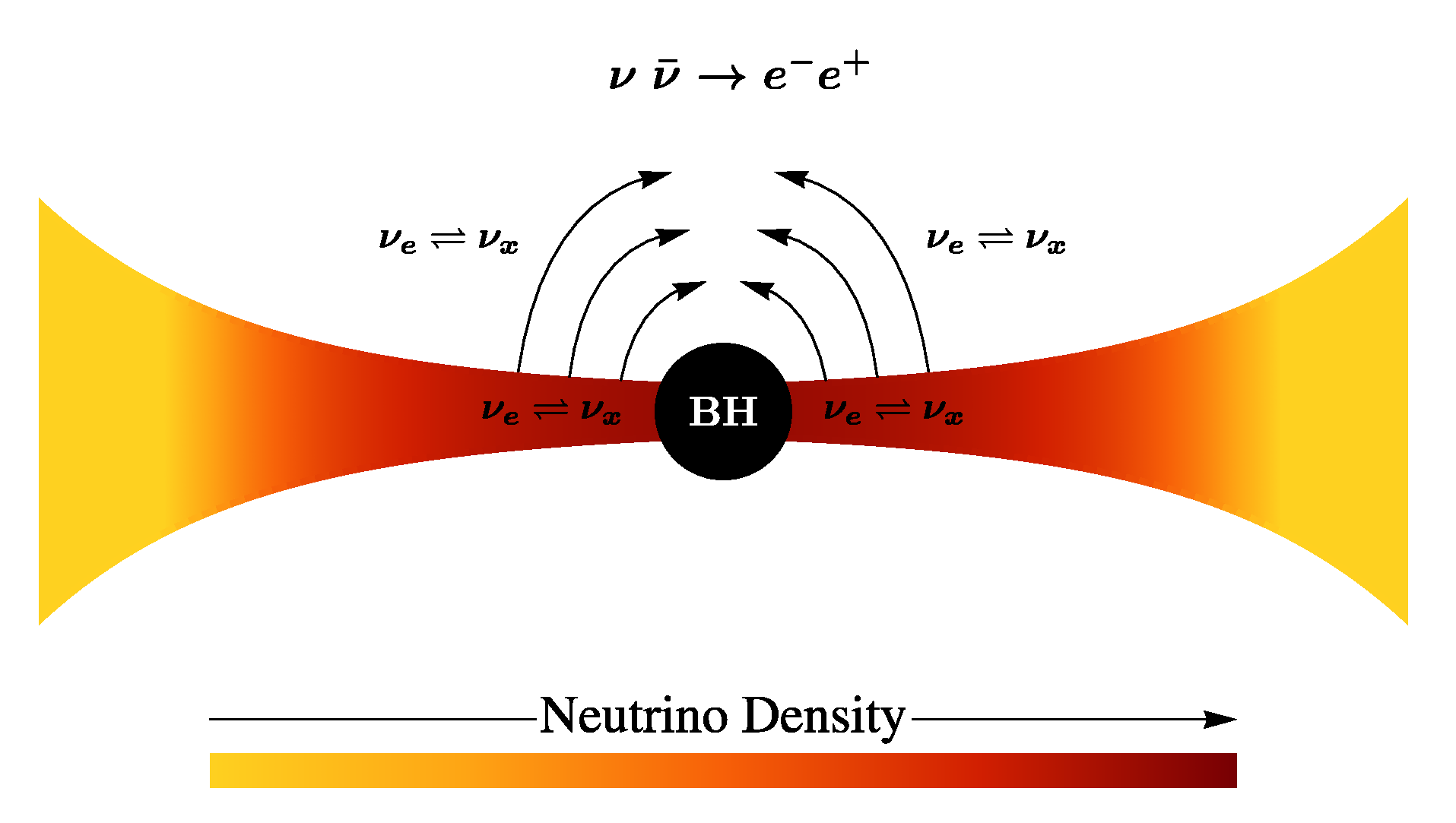
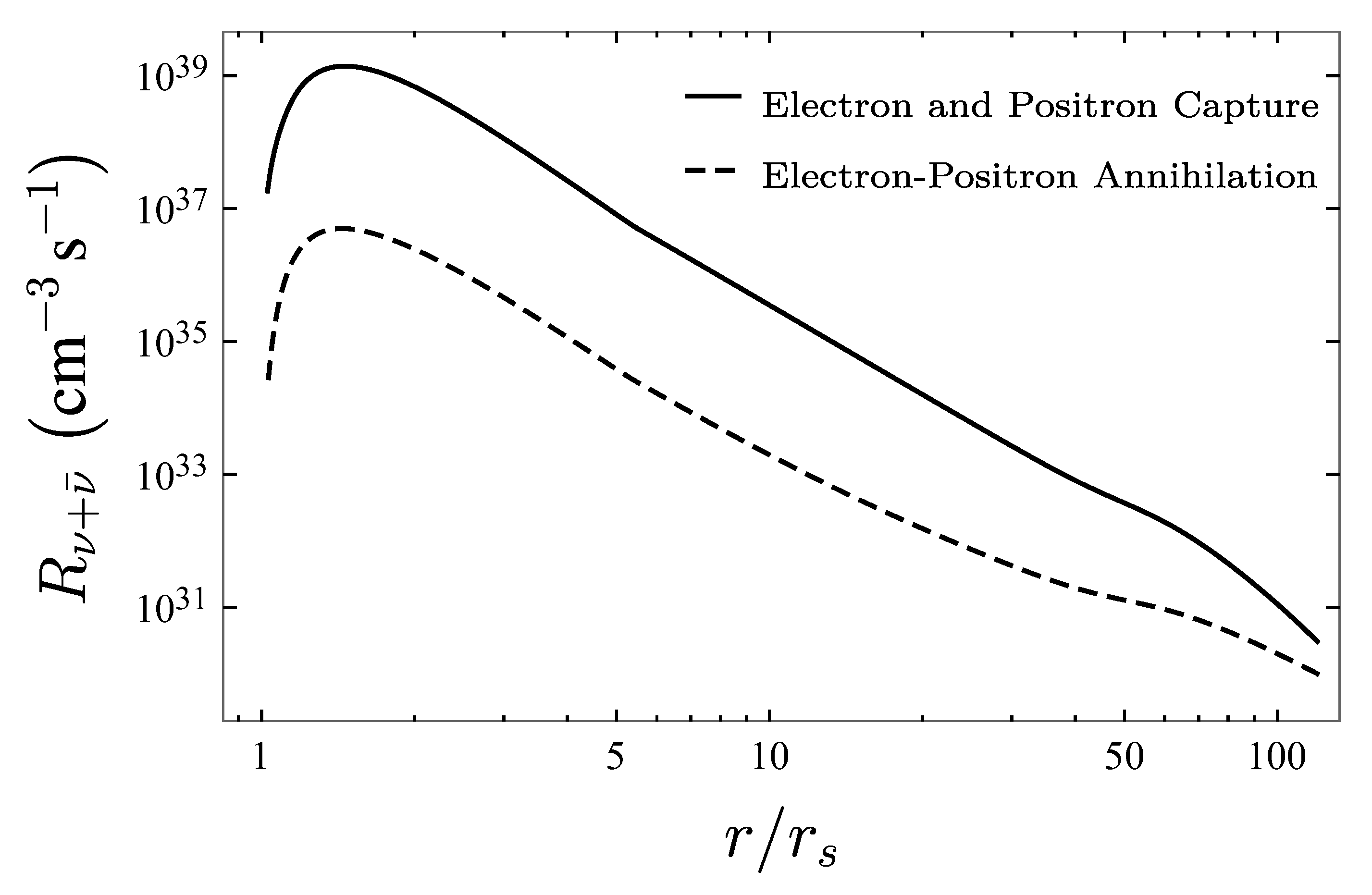

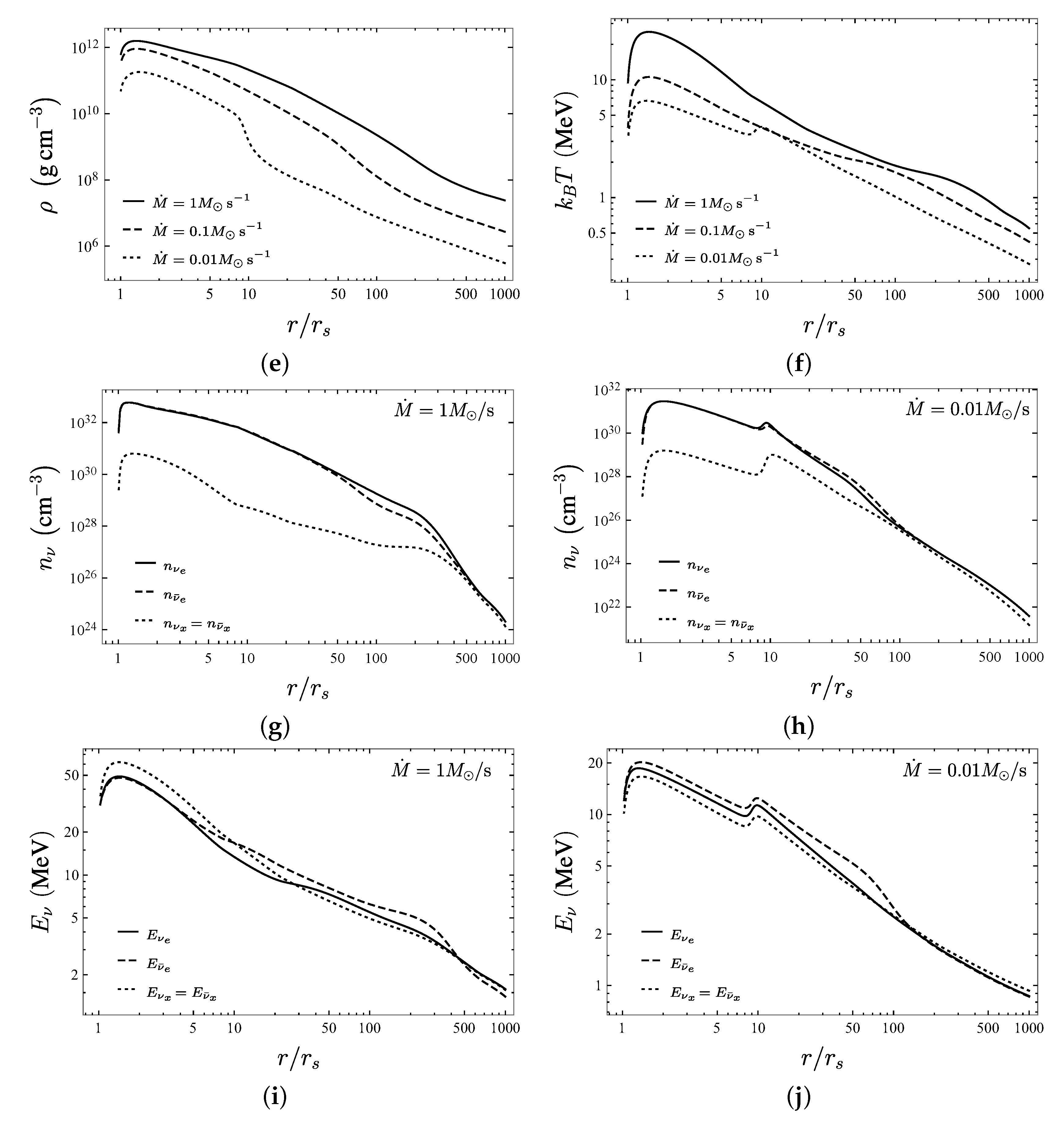
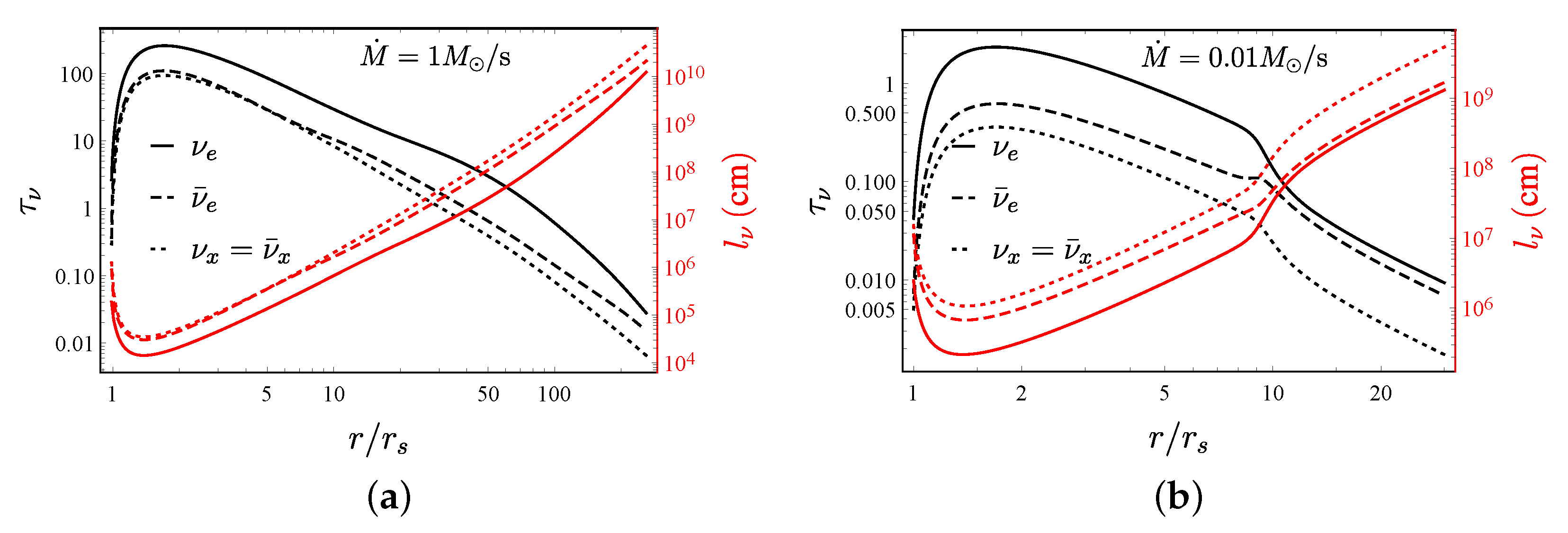
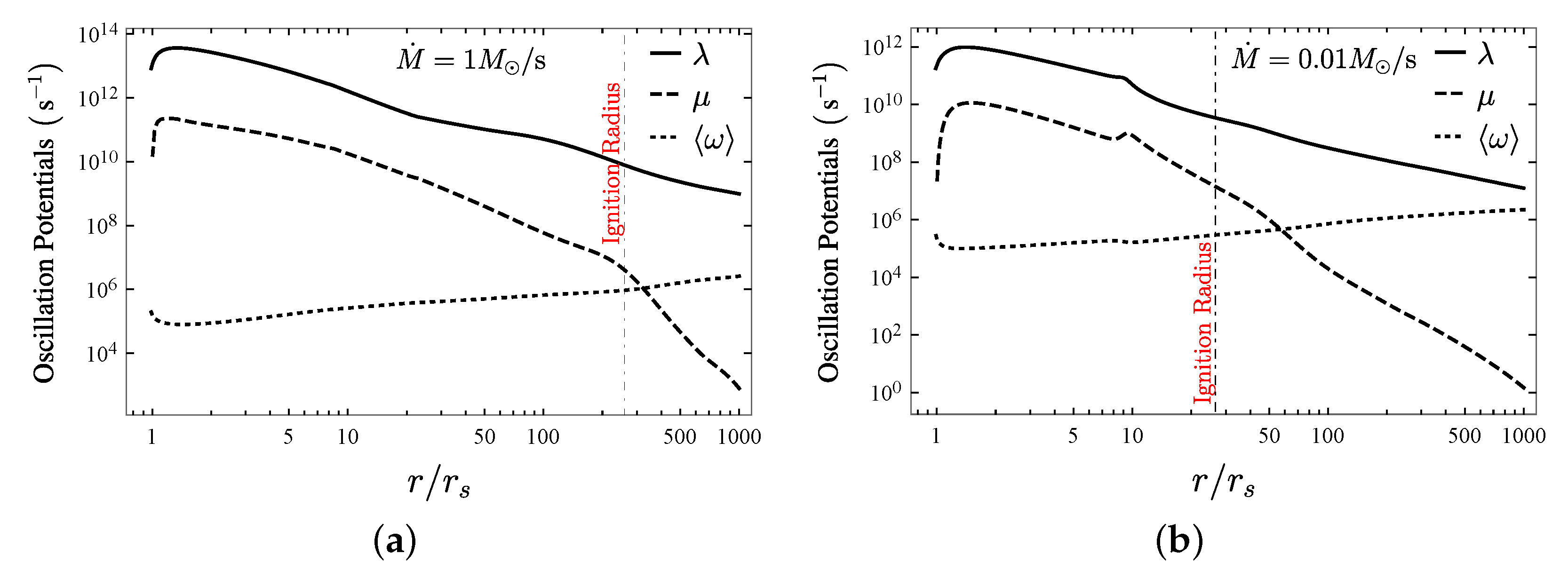
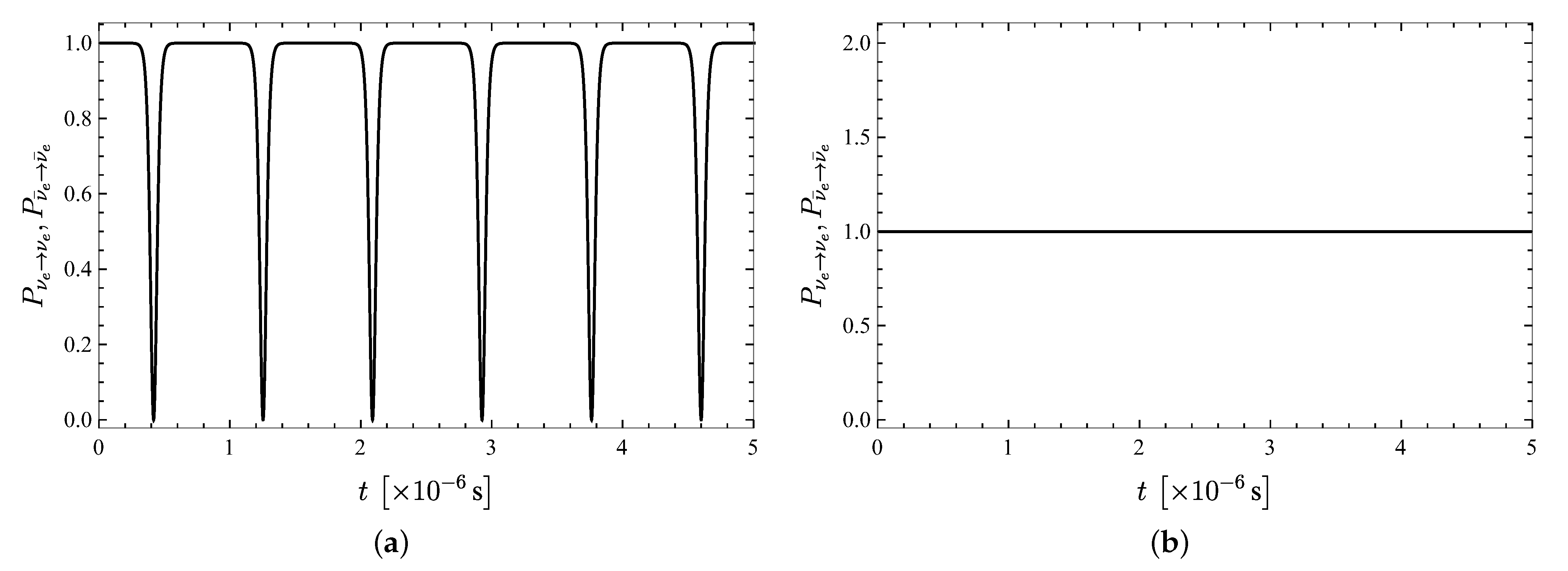
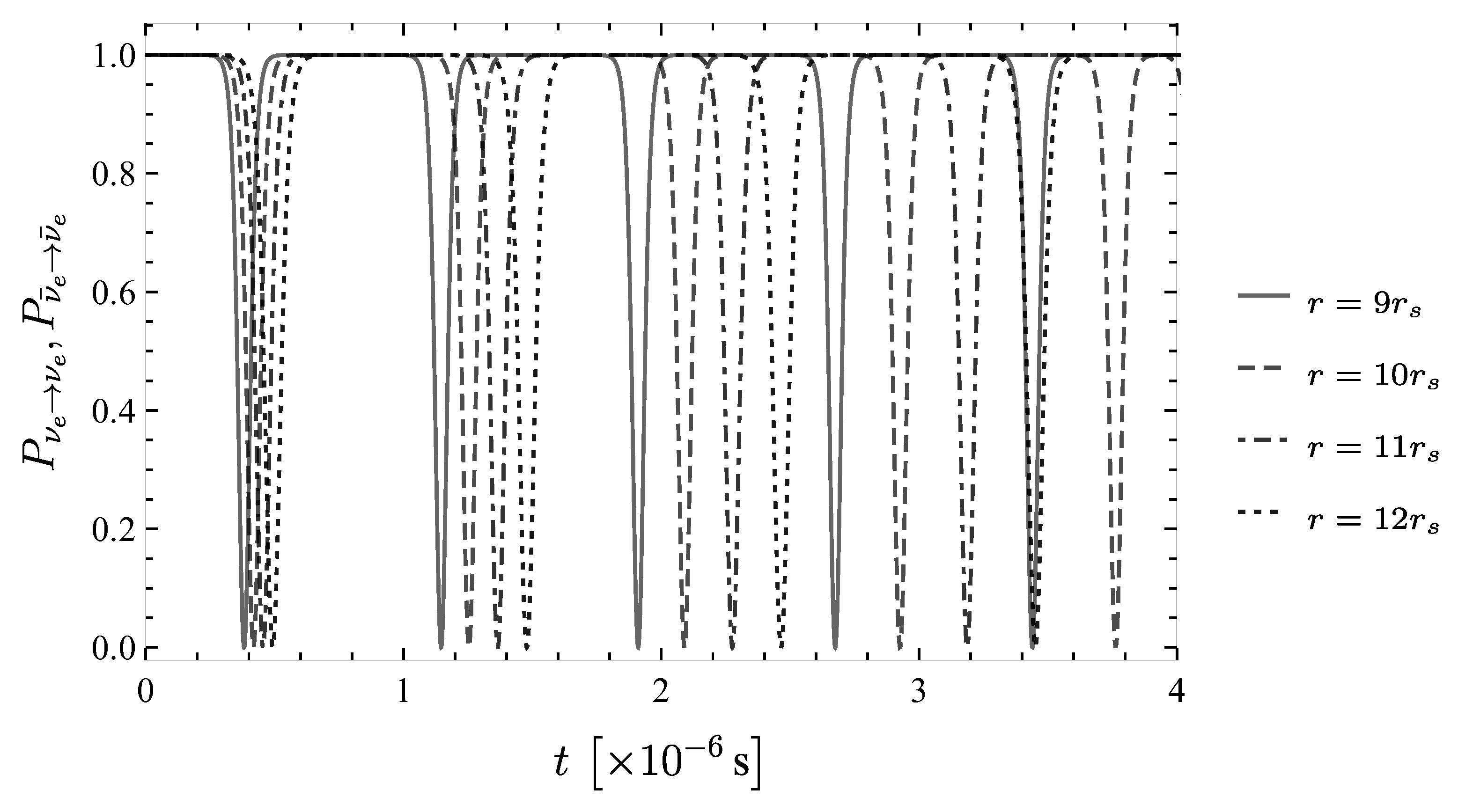
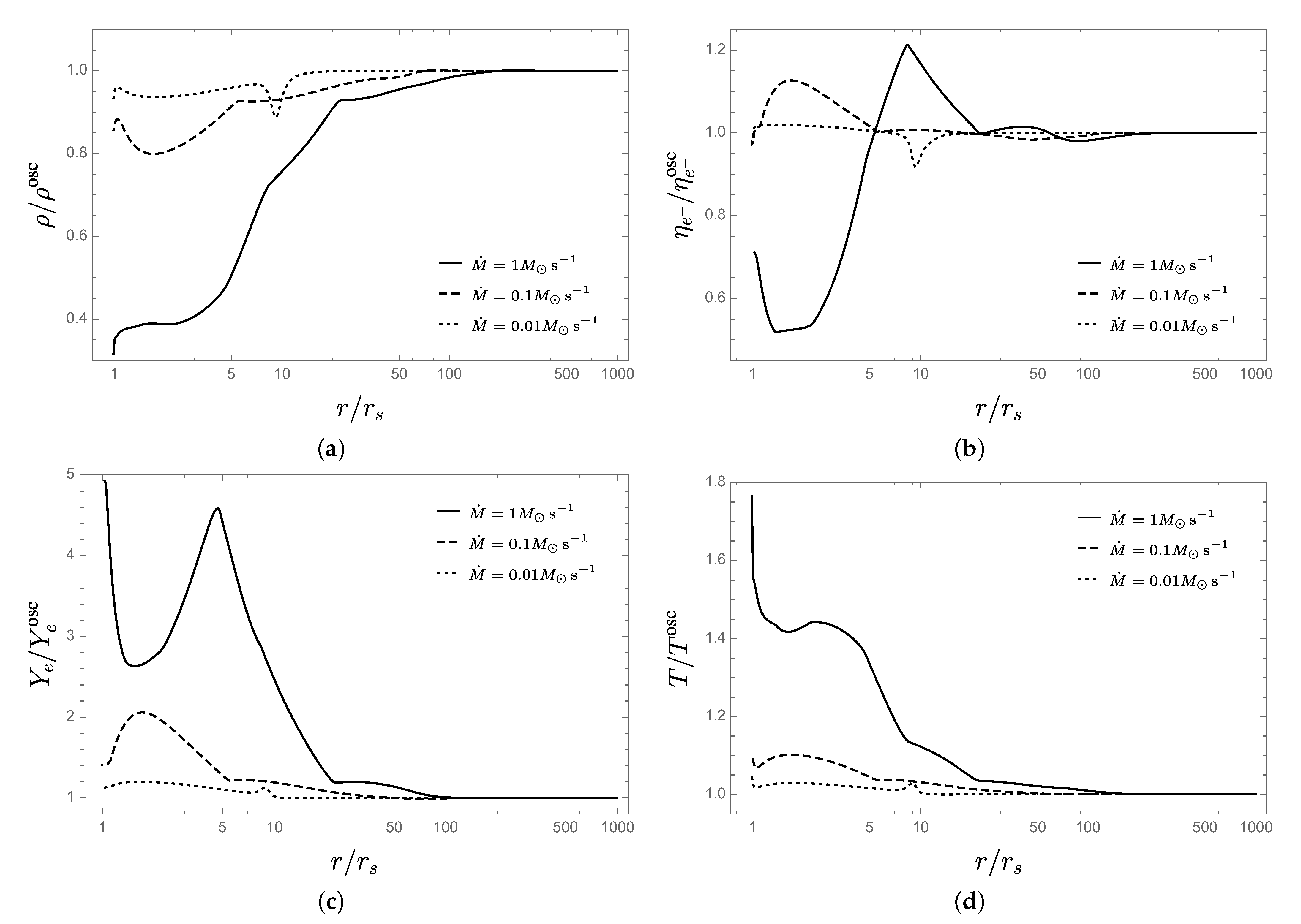
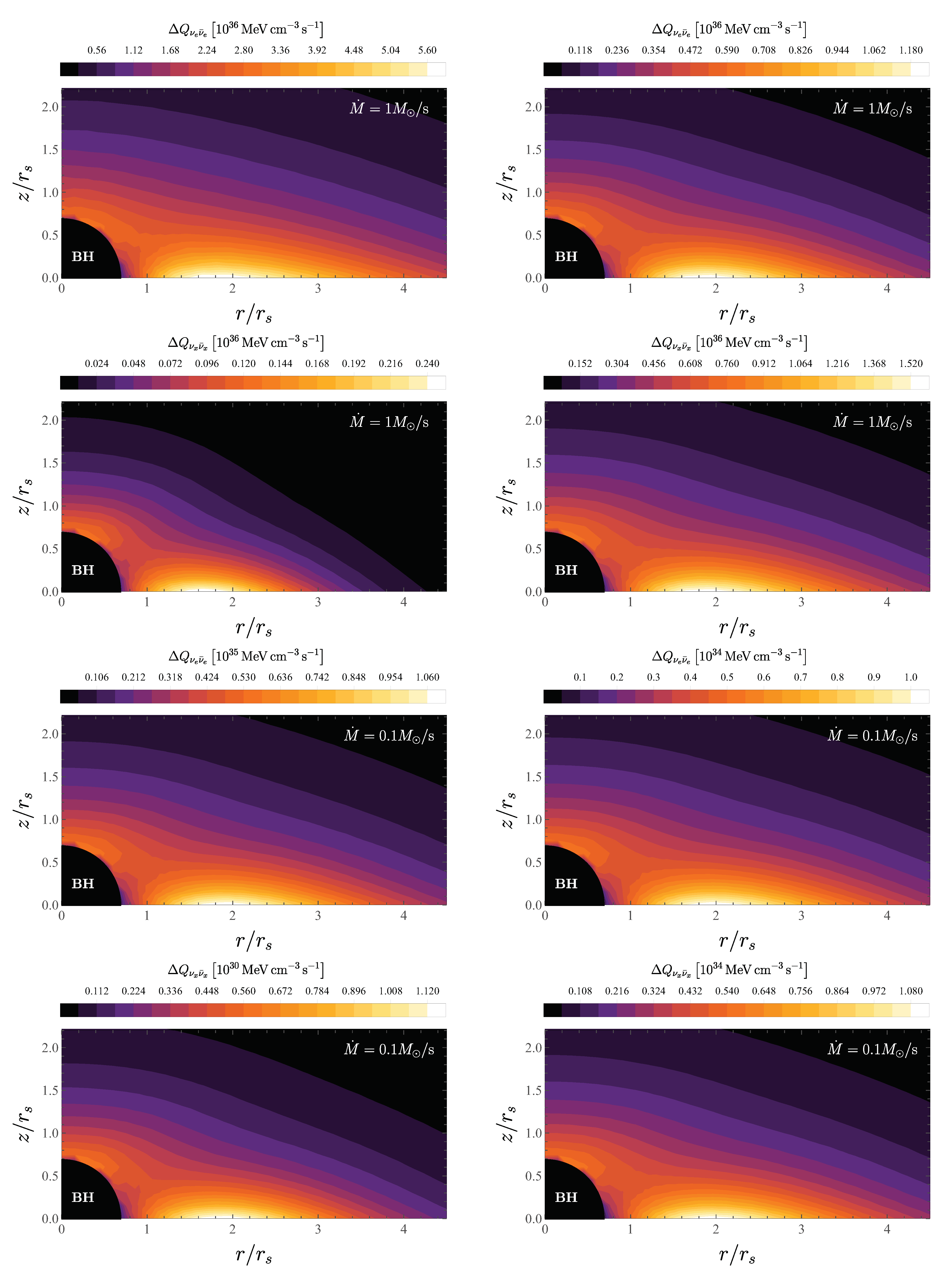
| BdHN Component/Phenomena | GRB Observable | ||||
|---|---|---|---|---|---|
| X-Ray Precursor | Prompt (MeV) | GeV-TeV Emission | X-Ray Flares Early Afterglow | X-Ray Plateau and Late Afterglow | |
| SN breakout | ⨂ | ||||
| Hypercrit. acc. onto the NS | ⨂ | ||||
| : transparency in low baryon load region | ⨂ | ||||
| Inner engine: BH + B + matter | ⨂ | ||||
| : transparency in high baryon load region e | ⨂ | ||||
| Synchrotron by NS injected particles on SN ejecta | ⨂ | ||||
| NS pulsar-like emission | ⨂ | ||||
| eV |
|---|
| eV Normal Hierarchy |
| eV Inverted Hierarchy |
| Without Oscillations | With Oscillations (Flavor Equipartition) | |||||||||||
|---|---|---|---|---|---|---|---|---|---|---|---|---|
| 1 s | ||||||||||||
| 0.1 s | ||||||||||||
| 0.01 s | ||||||||||||
Publisher’s Note: MDPI stays neutral with regard to jurisdictional claims in published maps and institutional affiliations. |
© 2021 by the authors. Licensee MDPI, Basel, Switzerland. This article is an open access article distributed under the terms and conditions of the Creative Commons Attribution (CC BY) license (http://creativecommons.org/licenses/by/4.0/).
Share and Cite
Uribe, J.D.; Becerra-Vergara, E.A.; Rueda, J.A. Neutrino Oscillations in Neutrino-Dominated Accretion Around Rotating Black Holes. Universe 2021, 7, 7. https://doi.org/10.3390/universe7010007
Uribe JD, Becerra-Vergara EA, Rueda JA. Neutrino Oscillations in Neutrino-Dominated Accretion Around Rotating Black Holes. Universe. 2021; 7(1):7. https://doi.org/10.3390/universe7010007
Chicago/Turabian StyleUribe, Juan David, Eduar Antonio Becerra-Vergara, and Jorge Armando Rueda. 2021. "Neutrino Oscillations in Neutrino-Dominated Accretion Around Rotating Black Holes" Universe 7, no. 1: 7. https://doi.org/10.3390/universe7010007
APA StyleUribe, J. D., Becerra-Vergara, E. A., & Rueda, J. A. (2021). Neutrino Oscillations in Neutrino-Dominated Accretion Around Rotating Black Holes. Universe, 7(1), 7. https://doi.org/10.3390/universe7010007







